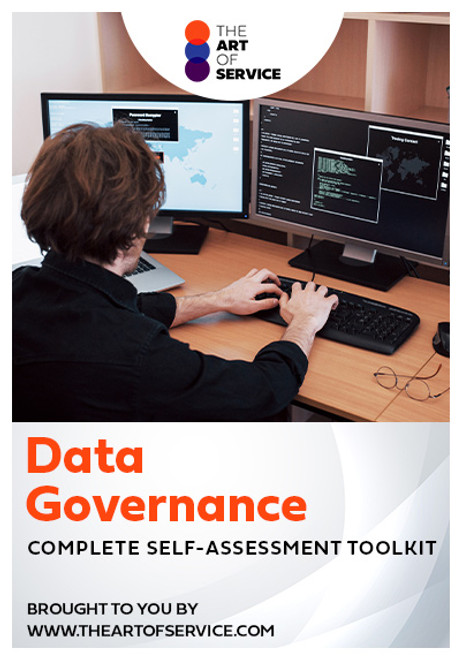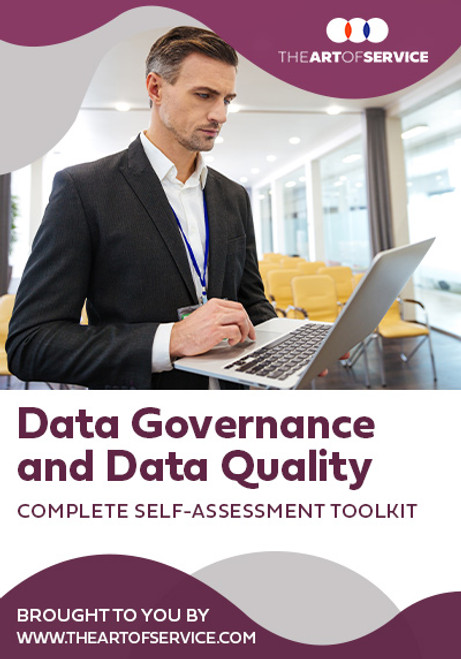Do you know the importance of Enterprise Data Governance?
Do you have an idea of how Enterprise Data Governance ensures that your organization incorporates data policies?
Save yourself the hassle and start empowering your organization and efficiently
execute your processes in a timely manner through instant access to our Enterprise
Data Governance toolkit and guide.
Our Enterprise Data Governance toolkit is available immediately as an instant download and contains powerful and new strategy for Enterprise Data Governance specific requirements.
STEP 1: Get your bearings
Start with...
- The latest quick edition of the Enterprise Data Governance Self Assessment book in PDF containing 49 requirements to perform a quickscan, get an overview and share with stakeholders.
Organized in a data driven improvement cycle RDMAICS (Recognize, Define, Measure, Analyze, Improve, Control and Sustain), check the…
- Example pre-filled Self-Assessment Excel Dashboard to get familiar with results generation
Then find your goals...
STEP 2: Set concrete goals, tasks, dates and numbers you can track
Featuring 991 new and updated case-based questions, organized into seven core areas of process design, this Self-Assessment will help you identify areas in which Enterprise Data Governance improvements can be made.
Examples; 10 of the 991 standard requirements:
- Are the already stated projects that focus iteratively, starting with the set of needs and data that provide the greatest value to the business in the shortest possible time the most successful?
- Which property of the core date warehouse layer of your enterprise data flow architecture uses common attributes to access a cross section of an information in the warehouse?
- What if decision makers throughout your business could access and analyze enterprise data a hundred times faster, a thousand times faster, or even ten thousand times faster?
- Have you ever experienced a situation where a trusted person (inside or outside your organization) forwarded or otherwise shared private/ confidential business information?
- Have you experienced any challenges in communicating with your organizations upper management about the importance of investing in data governance and data management?
- Have you launched a successful data warehouse, data lake, and/or data governance initiative and feel ready to build predictive models on your data sets as a next step?
- Have you experienced any successes in communicating with your organizations upper management about the importance of investing in data governance and data management?
- How many lines of business, functional areas, system areas, project teams, and other parts of your organization have committed stewardship resources or sponsorship?
- When designing the threat detection and mitigation portion for the enterprise data center network, which would be the most appropriate solution to consider?
- What formal or informal data governance processes do you have in place to ensure that spatial and business data are available across your organization?
Complete the self assessment, on your own or with a team in a workshop setting. Use the workbook together with the self assessment requirements spreadsheet:
- The workbook is the latest in-depth complete edition of the Enterprise Data Governance book in PDF containing 991 requirements, which criteria correspond to the criteria in...
Your Enterprise Data Governance self-assessment dashboard which gives you your dynamically prioritized projects-ready tool and shows your organization exactly what to do next:
- The Self-Assessment Excel Dashboard; with the Enterprise Data Governance Self-Assessment and Scorecard you will develop a clear picture of which Enterprise Data Governance areas need attention, which requirements you should focus on and who will be responsible for them:
- Shows your organization instant insight in areas for improvement: Auto generates reports, radar chart for maturity assessment, insights per process and participant and bespoke, ready to use, RACI Matrix
- Gives you a professional Dashboard to guide and perform a thorough Enterprise Data Governance Self-Assessment
- Is secure: Ensures offline data protection of your Self-Assessment results
- Dynamically prioritized projects-ready RACI Matrix shows your organization exactly what to do next:
STEP 3: Implement, Track, follow up and revise strategy
The outcomes of STEP 2, the self assessment, are the inputs for STEP 3; Start and manage Enterprise Data Governance projects with the 62 implementation resources:
- 62 step-by-step Enterprise Data Governance Project Management Form Templates covering over 1500 Enterprise Data Governance project requirements and success criteria:
Examples; 10 of the check box criteria:
- Schedule Management Plan: Is the plan consistent with industry best practices?
- Cost Management Plan: Have all team members been part of identifying risks?
- Activity Duration Estimates: How can you use Microsoft Enterprise Data Governance project and Excel to assist in Enterprise Data Governance project risk management?
- Activity Duration Estimates: Consider the common sources of risk on information technology Enterprise Data Governance projects and suggestions for managing them. Which suggestions do you find most useful?
- Project Management Plan: Was the peer (technical) review of the cost estimates duly coordinated with the cost estimate center of expertise and addressed in the review documentation and certification?
- Procurement Management Plan: Was the Enterprise Data Governance project schedule reviewed by all stakeholders and formally accepted?
- Monitoring and Controlling Process Group: What will you do to minimize the impact should a risk event occur?
- Procurement Management Plan: Is a stakeholder management plan in place that covers topics?
- Activity Duration Estimates: Will it help promote wellness at your organization and reduce insurance costs?
- Stakeholder Management Plan: Are requirements management tracking tools and procedures in place?
Step-by-step and complete Enterprise Data Governance Project Management Forms and Templates including check box criteria and templates.
1.0 Initiating Process Group:
- 1.1 Enterprise Data Governance project Charter
- 1.2 Stakeholder Register
- 1.3 Stakeholder Analysis Matrix
2.0 Planning Process Group:
- 2.1 Enterprise Data Governance project Management Plan
- 2.2 Scope Management Plan
- 2.3 Requirements Management Plan
- 2.4 Requirements Documentation
- 2.5 Requirements Traceability Matrix
- 2.6 Enterprise Data Governance project Scope Statement
- 2.7 Assumption and Constraint Log
- 2.8 Work Breakdown Structure
- 2.9 WBS Dictionary
- 2.10 Schedule Management Plan
- 2.11 Activity List
- 2.12 Activity Attributes
- 2.13 Milestone List
- 2.14 Network Diagram
- 2.15 Activity Resource Requirements
- 2.16 Resource Breakdown Structure
- 2.17 Activity Duration Estimates
- 2.18 Duration Estimating Worksheet
- 2.19 Enterprise Data Governance project Schedule
- 2.20 Cost Management Plan
- 2.21 Activity Cost Estimates
- 2.22 Cost Estimating Worksheet
- 2.23 Cost Baseline
- 2.24 Quality Management Plan
- 2.25 Quality Metrics
- 2.26 Process Improvement Plan
- 2.27 Responsibility Assignment Matrix
- 2.28 Roles and Responsibilities
- 2.29 Human Resource Management Plan
- 2.30 Communications Management Plan
- 2.31 Risk Management Plan
- 2.32 Risk Register
- 2.33 Probability and Impact Assessment
- 2.34 Probability and Impact Matrix
- 2.35 Risk Data Sheet
- 2.36 Procurement Management Plan
- 2.37 Source Selection Criteria
- 2.38 Stakeholder Management Plan
- 2.39 Change Management Plan
3.0 Executing Process Group:
- 3.1 Team Member Status Report
- 3.2 Change Request
- 3.3 Change Log
- 3.4 Decision Log
- 3.5 Quality Audit
- 3.6 Team Directory
- 3.7 Team Operating Agreement
- 3.8 Team Performance Assessment
- 3.9 Team Member Performance Assessment
- 3.10 Issue Log
4.0 Monitoring and Controlling Process Group:
- 4.1 Enterprise Data Governance project Performance Report
- 4.2 Variance Analysis
- 4.3 Earned Value Status
- 4.4 Risk Audit
- 4.5 Contractor Status Report
- 4.6 Formal Acceptance
5.0 Closing Process Group:
- 5.1 Procurement Audit
- 5.2 Contract Close-Out
- 5.3 Enterprise Data Governance project or Phase Close-Out
- 5.4 Lessons Learned
Results
With this Three Step process you will have all the tools you need for any Enterprise Data Governance project with this in-depth Enterprise Data Governance Toolkit.
In using the Toolkit you will be better able to:
- Diagnose Enterprise Data Governance projects, initiatives, organizations, businesses and processes using accepted diagnostic standards and practices
- Implement evidence-based best practice strategies aligned with overall goals
- Integrate recent advances in Enterprise Data Governance and put process design strategies into practice according to best practice guidelines
Defining, designing, creating, and implementing a process to solve a business challenge or meet a business objective is the most valuable role; In EVERY company, organization and department.
Unless you are talking a one-time, single-use project within a business, there should be a process. Whether that process is managed and implemented by humans, AI, or a combination of the two, it needs to be designed by someone with a complex enough perspective to ask the right questions. Someone capable of asking the right questions and step back and say, 'What are we really trying to accomplish here? And is there a different way to look at it?'
This Toolkit empowers people to do just that - whether their title is entrepreneur, manager, consultant, (Vice-)President, CxO etc... - they are the people who rule the future. They are the person who asks the right questions to make Enterprise Data Governance investments work better.
This Enterprise Data Governance All-Inclusive Toolkit enables You to be that person.
Includes lifetime updates
Every self assessment comes with Lifetime Updates and Lifetime Free Updated Books. Lifetime Updates is an industry-first feature which allows you to receive verified self assessment updates, ensuring you always have the most accurate information at your fingertips.











